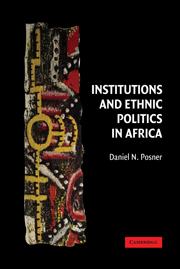II - Introduction to Part II
Accounting for Ethnic Coalition-Building Choices
Published online by Cambridge University Press: 05 June 2012
Summary
As a consequence of the administrative policies of the Northern Rhodesian colonial state and its missionary and mining company partners, Zambians in the post-independence era came to view both their own ethnic identities and the country's larger social landscape in terms of two competing schemes of ethnic classification: one defined by affiliation with one of the country's six dozen tribes, and the other defined by membership in one of the country's four principal language groups. Each scheme of ethnic classification implies a very different landscape of political competition and conflict. It also provides people with a very different set of criteria for determining, in the course of that competition and conflict, who is and is not a member of their ethnic group.
The question is: given this ethnic multi-dimensionality, can we generalize about the conditions under which Zambians understand politics as a struggle among the country's tribes rather than as a conflict among its language groups? Can we construct an explanation to account for when one of these ethnic cleavages will become politically salient rather than the other? Part I furnished the background necessary to ask these questions. Part II provides the empirical and theoretical tools with which to answer them.
Chapter 4 provides the foundation for our explanation by showing why ethnicity matters in Zambia and how it is used politically. The chapter shows that ethnicity matters because of the widespread expectation that politicians will channel patronage resources to members of their own ethnic groups.
- Type
- Chapter
- Information
- Institutions and Ethnic Politics in Africa , pp. 89 - 90Publisher: Cambridge University PressPrint publication year: 2005

